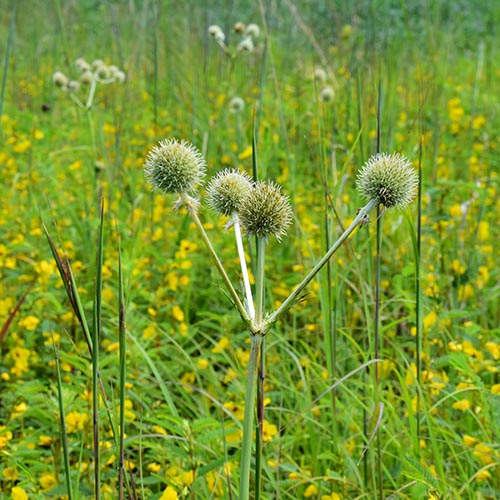
Listen to this Episode:
- From this webpage:
- Find the media player located under the episode picture.
- Click on the green triangle to listen to the audio for this episode.
- From your favorite podcast listening platform:
- Search for “Backyard Ecology.”
Show notes:
When it comes to planting for pollinators or gardening for pollinators, the traditional advice has always been to plant larger patch sizes or clumps of plants. The thought is that the larger patch sizes will be easier to see and more attractive to pollinators than smaller clumps or patch sizes. But saying that assumes that all pollinators are attracted to the same thing and that they respond to different species of plants in the same way.
In this episode of the Backyard Ecology podcast, we talk with Tristan Barley. Tristan recently received his Masters degree from Miami University in Ohio, and is currently a PhD student in Entomology at the University of Illinois. The research that Tristan conducted for his Master’s thesis questioned the traditional advice.
Tristan’s research looked at whether all pollinators prefer larger patch sizes and whether those preferences would vary not only based on the type of pollinator but also based on the type of plant. Perhaps, not surprisingly, he found that patch size preferences were different for some pollinators compared to others, specifically bumble bees and some of our tiny bees. He also found that the species of flower sometimes influenced the pollinator’s patch size preference. In addition, Tristan looked at how different patch sizes affected seed production in one of the plant species he studied. It was interesting to think about the influences of patch size from the plant’s perspective, and not just from the pollinator’s perspective.
Our conversation discussed his research including what his findings meant from a practical standpoint and how we can apply his findings in our own pollinator gardens and pollinator plantings. We also talked about how many different types of animals visit flowers and how much happens on a flower. We both recommend taking time to just stare at a flower and enjoy getting to know everything that visits the flower.
Links:
- Do Pollinators Prefer Dense Flower Patches? Sometimes Yes, Sometimes No: https://entomologytoday.org/2022/01/12/pollinators-prefer-dense-flower-patches-sometimes-yes-no/
- The Effects of Flower Patch Density on Pollinator Visitation: https://etd.ohiolink.edu/apexprod/rws_etd/send_file/send?accession=miami1605828141532099&disposition=inline
- Bauer Lab at Miami University: https://jonathantbauer.com/
- The Dolezal Bee Research Lab: https://publish.illinois.edu/dolezalbeelab/
- Backyard Ecology’s website: https://backyardecology.net
- Related Backyard Ecology resources:
- Conserving our Southeastern Grasslands with Dwayne Estes: https://www.backyardecology.net/conserving-our-southeastern-grasslands-with-dwayne-estes/
- Backyard Ecology blog: https://www.backyardecology.net/blog/
- Backyard Ecology’s Patreon page: https://www.patreon.com/backyardecology
- Subscribe to Backyard Ecology emails: https://www.backyardecology.net/subscribe/
- My email: shannon@backyardecology.net
Episode image:
- Rattlesnake master (Eryngium yuccifolium)growing in a prairie.
- Photo credit: Jason Johnson, Iowa NRCS, public domain

Backyard Ecology: Exploring Nature in Your Backyard
Nature isn’t just “out there.” It’s all around us, including right outside our doors. Hi, my name is Shannon Trimboli, and I am the host of Backyard Ecology. I live in southcentral Kentucky and am a wildlife biologist, educator, author, beekeeper, and owner of a nursery specializing in plants for pollinators and wildlife conservation. I invite you to join me as we ignite our curiosity and natural wonder, explore our yards and communities, and improve our local pollinator and wildlife habitat. Learn more or subscribe to my email list at www.backyardecology.net.

Leave a Reply